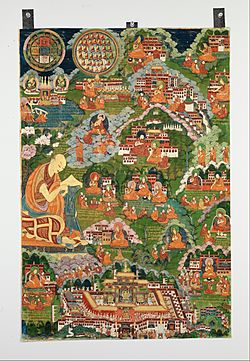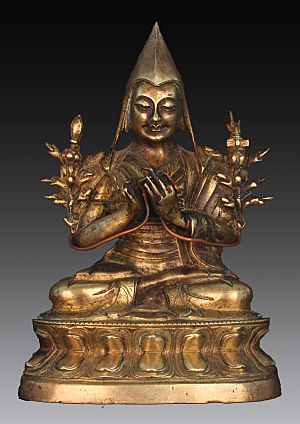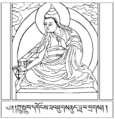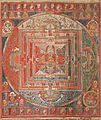Je Tsongkhapa facts for kids
Quick facts for kids
Tsongkhapa, Wylie:tsong kha pa
Tibetan:ཙོང་ཁ་པ། Traditional Chinese:宗喀巴, Simplified:宗喀巴, Pinyin:Zōngkàbā |
|
|---|---|
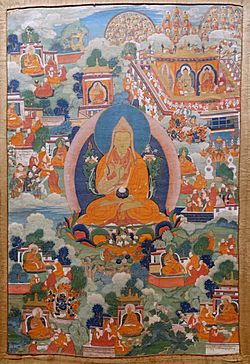
Thangka of Tsongkhapa - Sichuan University Museum - Chengdu, China
|
|
| Born | c. 1357 CE Amdo
|
| Died | c. 1419 CE (aged 61–62) |
| Occupation | Buddhist teacher, monk and philosopher |
| Known for | Founder of the Gelug school |
Tsongkhapa (born around 1357 CE, died around 1419 CE) was a very important teacher in Tibetan Buddhism. His name means "the man from Tsongkha," which was a place in Amdo. His teachings led to the creation of the Gelug school of Tibetan Buddhism. People also knew him by his special name, Losang Drakpa, or simply "Je Rinpoche." He was the son of a Tibetan tribal leader.
Tsongkhapa wrote two main books: the Lamrim Chenmo and Ngakrim Chenmo. In these books, he carefully explained a step-by-step way to follow the Buddhist path. He showed how to combine the teachings of sutra (basic Buddhist texts) and tantra (more advanced spiritual practices).
Contents
Biography
Early years
Tsongkhapa was born in 1357 in a walled city called Tsongkha in Amdo, Tibet. His father was Mongolian and his mother was Tibetan. When he was very young, at age three, he took his first vows. He was named Künga Nyingpo.
At seven years old, he became a young monk (a śrāmaṇera). His teacher, Döndrup Rinchen, gave him the name Losang Drakpa. It is said that the Buddha Sakyamuni himself predicted Tsongkhapa's coming. The Buddha said that Tsongkhapa would appear as an ordinary person but would act like a Buddha. He would help establish a joyful land in Tibet.
Monastic career
Even at a young age, Tsongkhapa received special teachings and could recite many important Buddhist texts. He studied the vinaya, which are rules for monks. He also learned advanced practices like the Six Yogas of Naropa and the Kalachakra tantra. When he was 24, he became a fully ordained monk in the Sakya school.
Tsongkhapa learned from many different masters from various Buddhist traditions. He studied with teachers from the Sakya, Kagyu, and Nyingma schools. He also spent a lot of time meditating. People say he did millions of prostrations and other purification practices. Tsongkhapa often had visions of special beings, especially Manjusri, who helped him understand difficult parts of the scriptures.
Honours
Tsongkhapa was one of the most respected Buddhist teachers of his time. He wrote a special prayer for his teacher, Rendawa, called the Migtsema Prayer. But Rendawa gave it back to Tsongkhapa, saying the verses were more fitting for Tsongkhapa himself.
Death
Tsongkhapa passed away in 1419 when he was 62 years old. After his death, many biographies were written about him. Other important Buddhist leaders praised him. For example, the Wangchuk Dorje, 9th Karmapa Lama said Tsongkhapa "swept away wrong views with the correct and perfect ones." The Mikyö Dorje, 8th Karmapa Lama wrote a poem praising Tsongkhapa for bringing Buddha's teachings back to life in Tibet.
Philosophy and practice
Background
Tsongkhapa knew all the Tibetan Buddhist traditions of his time. He received teachings from many different schools. His main inspiration came from the Kadam school, which was started by Atiśa. Tsongkhapa's teachings built on Atiśa's ideas. He stressed the importance of studying the Vinaya (monastic rules) and other Buddhist texts.
Tsongkhapa also taught a lot about Vajrayana (a type of tantric Buddhism). He showed how to bring together the Sutra and Tantra teachings. He wrote books that explained the main ideas of Buddhist philosophy. He also wrote commentaries on important texts about behavior, wisdom, and tantra.
Understanding emptiness
For Tsongkhapa, just meditating quietly was not enough. He believed it was important to think deeply and clearly. This helps to gain a breakthrough in understanding.
Tsongkhapa taught about sunyata, or "emptiness." This means that things do not have a fixed, independent nature of their own. Instead, everything comes into being because of other things. This idea is called "dependent arising."
According to Tsongkhapa, dependent arising and emptiness are always connected. Things appear to exist in the world, and we use names and ideas for them. But if you look very closely, you won't find anything that exists completely on its own, without depending on anything else. This doesn't mean nothing exists at all. It means things exist, but not in the way we often imagine, as solid and separate.
Tsongkhapa explained that emptiness is not a "thing" itself. It's the absence of things having their own independent nature. It's like saying a room is "empty" of an elephant. "Elephant-lessness" isn't a new thing in the room; it's just the fact that the elephant isn't there. Similarly, emptiness is the absence of inherent existence.
Influence
New tradition
Sam van Schaik says that Tsongkhapa "wanted to create something new." His followers became known as "Gandenbas." Tsongkhapa himself did not officially announce a new monastic order.
Monasticism and lineage
Tsongkhapa strongly believed in having a strong community of monks (a Sangha). In 1409, he founded the Ganden Monastery. This monastery became the foundation for what was later called the Gelug ("virtuous ones") order.
Tsongkhapa had many important students. Some of the most famous were Gyaltsab Je, Khedrup Gelek Pelzang, 1st Panchen Lama, and the 1st Dalai Lama. After Tsongkhapa passed away, his teachings were continued by Gyaltsab Dharma Rinchen and Khedrub Gelek Pälsang. Today, his lineage is continued by the Ganden Tripas, who are the leaders of Ganden Monastery.
Many Gelug monasteries were built throughout Tibet, China, and Mongolia. These include Drepung Monastery, Sera Monastery, and Tashilhunpo Monastery. Tsongkhapa also spent time as a hermit in Pabonka Hermitage.
Important leaders in the Gelug school include the Panchen Lamas and many other respected teachers.
Prayer Festival
Tsongkhapa also started the yearly Tibetan prayer festival called Monlam Prayer Festival. During this festival, he served ten thousand monks. Starting this Great Prayer Festival is seen as one of his Four Great Deeds. It celebrates the amazing things that Gautama Buddha did.
Works
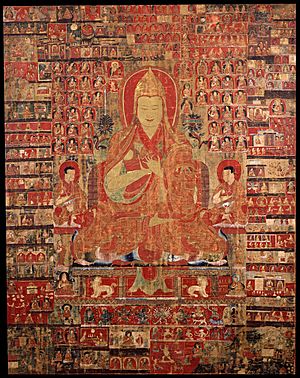
Tsongkhapa encouraged the study of logic and formal debates. He also taught his students about various Guhyasamāja, Kalacakra, and Hevajra Tantras. Tsongkhapa's writings fill eighteen volumes. Most of his writings are about the Guhyasamāja tantra. These books explain many parts of Buddhist teachings and help make difficult topics clearer. His main writings on Madhyamaka philosophy follow the tradition of Nagarjuna, as explained by Buddhapālita and Candrakīrti.
Major works
Some of his most important books are:
- The Great Treatise on the Stages of the Path to Enlightenment (lam rim chen mo)
- The Great Exposition of Secret Mantra (sngags rim chen mo)
- Essence of True Eloquence (drang nges legs bshad snying po)
- Ocean of Reasoning: A Great Commentary on Nagarjuna's Mulamadhyamakakarika
- Brilliant Illumination of the Lamp of the Five Stages
- Golden Garland of Eloquence
- The Praise of Relativity
English translations
Many of Tsongkhapa's works have been translated into English, including:
- Life and Teachings of Tsongkhapa
- The Great Treatise On The Stages Of The Path To Enlightenment (in three volumes)
- Dependent-Arising and Emptiness: A Tibetan Buddhist Interpretation of Mādhyamika Philosophy
- The Medium Treatise On The Stages Of The Path To Enlightenment
- Golden Garland of Eloquence (in four volumes)
- Ocean of Reasoning: A Great Commentary on Nagarjuna's Mulamadhyamakakarika
- Essence of True Eloquence
- Tantric Ethics: An Explanation of the Precepts for Buddhist Vajrayana Practice
- The Six Yogas of Naropa: Tsongkhapa's Commentary
- Brilliant Illumination of the Lamp of the Five Stages
- The Splendor of an Autumn Moon: The Devotional Verse of Tsongkhapa
- Three Principal Aspects of the Path
Images for kids
See also
 In Spanish: Je Tsongkhapa para niños
In Spanish: Je Tsongkhapa para niños


